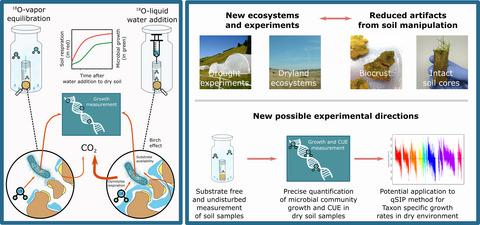当前位置:
X-MOL 学术
›
Glob. Change Biol.
›
论文详情
Our official English website, www.x-mol.net, welcomes your
feedback! (Note: you will need to create a separate account there.)
Quantifying microbial growth and carbon use efficiency in dry soil environments via 18 O water vapor equilibration.
Global Change Biology ( IF 10.8 ) Pub Date : 2020-05-30 , DOI: 10.1111/gcb.15168 Alberto Canarini 1 , Wolfgang Wanek 1 , Margarete Watzka 1 , Taru Sandén 2 , Heide Spiegel 2 , Jiří Šantrůček 3 , Jörg Schnecker 1
Global Change Biology ( IF 10.8 ) Pub Date : 2020-05-30 , DOI: 10.1111/gcb.15168 Alberto Canarini 1 , Wolfgang Wanek 1 , Margarete Watzka 1 , Taru Sandén 2 , Heide Spiegel 2 , Jiří Šantrůček 3 , Jörg Schnecker 1
Affiliation

|
Soil microbial physiology controls large fluxes of C to the atmosphere, thus, improving our ability to accurately quantify microbial physiology in soil is essential. However, current methods to determine microbial C metabolism require liquid water addition, which makes it practically impossible to measure microbial physiology in dry soil samples without stimulating microbial growth and respiration (namely, the “Birch effect”). We developed a new method based on in vivo 18O‐water vapor equilibration to minimize soil rewetting effects. This method allows the isotopic labeling of soil water without direct liquid water addition. This was compared to the main current method (direct 18O‐liquid water addition) in moist and air‐dry soils. We determined the time kinetics and calculated the average 18O enrichment of soil water over incubation time, which is necessary to calculate microbial growth from 18O incorporation in genomic DNA. We tested isotopic equilibration patterns in three natural and six artificially constructed soils covering a wide range of soil texture and soil organic matter content. We then measured microbial growth, respiration and carbon use efficiency (CUE) in three natural soils (either air‐dry or moist). The proposed 18O‐vapor equilibration method provided similar results as the current method of liquid 18O‐water addition when used for moist soils. However, when applied to air‐dry soils the liquid 18O‐water addition method overestimated growth by up to 250%, respiration by up to 500%, and underestimated CUE by up to 40%. We finally describe the new insights into biogeochemical cycling of C that the new method can help uncover, and we consider a range of questions regarding microbial physiology and its response to global change that can now be addressed.
中文翻译:

通过 18 O 水蒸气平衡量化干燥土壤环境中的微生物生长和碳利用效率。
土壤微生物生理学控制大量 C 流入大气,因此,提高我们准确量化土壤中微生物生理学的能力至关重要。然而,目前确定微生物 C 代谢的方法需要添加液态水,这使得在不刺激微生物生长和呼吸(即“桦木效应”)的情况下测量干燥土壤样品中的微生物生理几乎是不可能的。我们开发了一种基于体内18 O-水蒸气平衡的新方法,以最大限度地减少土壤再润湿效应。该方法允许在不直接添加液态水的情况下对土壤水进行同位素标记。这与当前的主要方法(直接18O-液态水添加)在潮湿和空气干燥的土壤中。我们确定了时间动力学并计算了土壤水在孵育时间内的平均18 O富集,这是根据基因组 DNA 中的18 O 掺入计算微生物生长所必需的。我们在三种天然和六种人工构建的土壤中测试了同位素平衡模式,涵盖了广泛的土壤质地和土壤有机质含量。然后,我们测量了三种天然土壤(风干或潮湿)中的微生物生长、呼吸作用和碳利用效率(CUE)。所提出的18 O-蒸气平衡方法提供了与液体18的当前方法相似的结果用于潮湿土壤时添加 O-水。然而,当应用于风干土壤时,液体18 O-水添加方法高估了高达 250% 的生长,高达 500% 的呼吸作用,并低估了高达 40% 的 CUE。最后,我们描述了新方法可以帮助揭示的对 C 的生物地球化学循环的新见解,并且我们考虑了一系列关于微生物生理学及其对全球变化的反应的问题,这些问题现在可以得到解决。
更新日期:2020-05-30
中文翻译:

通过 18 O 水蒸气平衡量化干燥土壤环境中的微生物生长和碳利用效率。
土壤微生物生理学控制大量 C 流入大气,因此,提高我们准确量化土壤中微生物生理学的能力至关重要。然而,目前确定微生物 C 代谢的方法需要添加液态水,这使得在不刺激微生物生长和呼吸(即“桦木效应”)的情况下测量干燥土壤样品中的微生物生理几乎是不可能的。我们开发了一种基于体内18 O-水蒸气平衡的新方法,以最大限度地减少土壤再润湿效应。该方法允许在不直接添加液态水的情况下对土壤水进行同位素标记。这与当前的主要方法(直接18O-液态水添加)在潮湿和空气干燥的土壤中。我们确定了时间动力学并计算了土壤水在孵育时间内的平均18 O富集,这是根据基因组 DNA 中的18 O 掺入计算微生物生长所必需的。我们在三种天然和六种人工构建的土壤中测试了同位素平衡模式,涵盖了广泛的土壤质地和土壤有机质含量。然后,我们测量了三种天然土壤(风干或潮湿)中的微生物生长、呼吸作用和碳利用效率(CUE)。所提出的18 O-蒸气平衡方法提供了与液体18的当前方法相似的结果用于潮湿土壤时添加 O-水。然而,当应用于风干土壤时,液体18 O-水添加方法高估了高达 250% 的生长,高达 500% 的呼吸作用,并低估了高达 40% 的 CUE。最后,我们描述了新方法可以帮助揭示的对 C 的生物地球化学循环的新见解,并且我们考虑了一系列关于微生物生理学及其对全球变化的反应的问题,这些问题现在可以得到解决。





















































 京公网安备 11010802027423号
京公网安备 11010802027423号